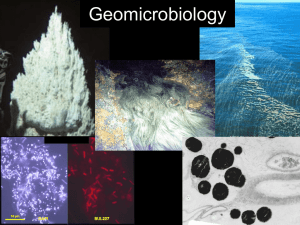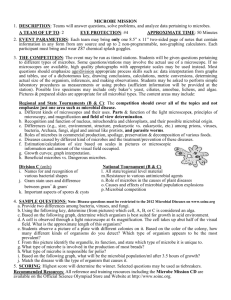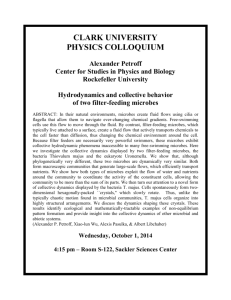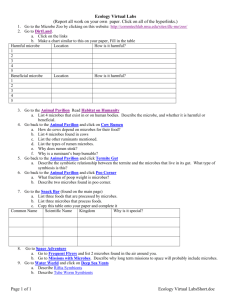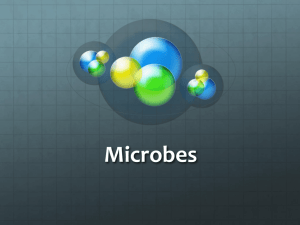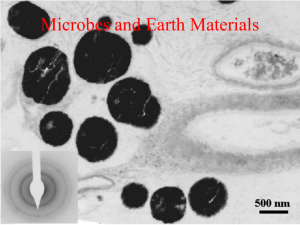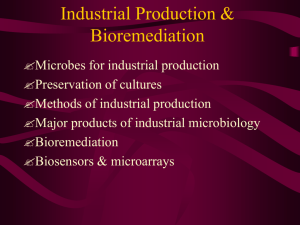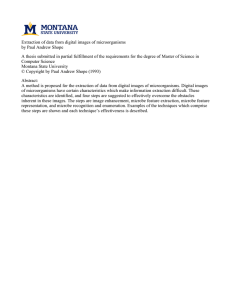MICR 201 Microbiology for Health Related Sciences
advertisement
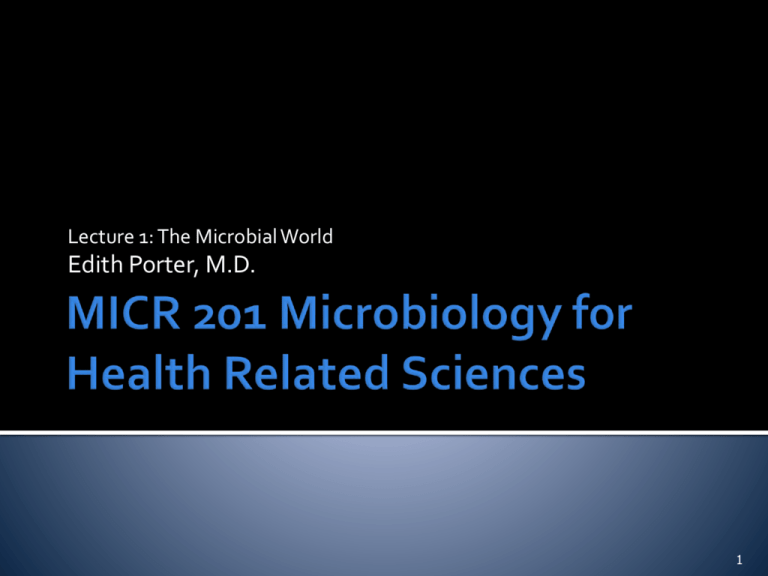
Lecture 1: The Microbial World Edith Porter, M.D. 1 Definition of Microbiology Size dimensions Classification of microbial agents Microbial diversity Role of microbes in nature Beneficial ▪ Environment ▪ Normal microbiota ▪ Commercial use and industrial applications Harmful ▪ Disease causing History of Microbiology 2 Micro Small (micrometer range) Not visible with the unaided eye Bio Living Able to reproduce 3 1 inch 1 cm 1 mm (1/10 of 1 cm) 1 mm (1/1000 of 1 mm) Human Egg cell (almost 1 mm) Erythrocyte (7 mm) Bacterium (2 –4 mm) 1 nm (1/1000 of 1 mm) Large Virus (200 nm) 4 Cellular organisms Eukaryotes (have a nucleus) Prokaryotes (do not have a nucleus) Cell membrane Nucleus with genetic material Cell membrane Genetic material in cytoplasm Nuclear membrane Acellular agents Viruses (nucleic acid + protein) Viroids (nucleic acid) Prions (protein) 5 Prokaryotes Domain Bacteria Domain Archaea Protozoa Algae Fungi Slime molds Protists Plants Animals Helminths Domain Eukarya Eukaryotes 6 Bacteria Peptidoglycan cell walls Binary fission For energy, use organic chemicals, inorganic chemicals, or photosynthesis Some produce molecular oxygen Archaea No peptidoglycan Often in extreme environments Diverse metabolic pathways Not known to cause disease 7 Cellulose cell walls Use photosynthesis for energy Produce molecular oxygen and organic compounds 8 Chitin cell walls Use organic chemicals for energy Two forms Molds ▪ Multicellular ▪ Consisting of masses of mycelia composed of filaments called hyphae Yeasts ▪ Unicellular Dimorphic shift 9 Unicellular Absorb or ingest organic chemicals May be motile via pseudopods, cilia, or flagella 10 Multicellular animals Parasitic flatworms and roundworms are called helminths Microscopic stages in life cycles Dirofilaria immitis Viruses are replicated only when they are in a living host cell Consist of DNA or RNA core Core is surrounded by a protein coat Coat may be enclosed in a lipid envelope (from host cell) Not all viruses are harmful! Proteinaceous infectious particles Consist of protein only Prions induce conformation changes of normal counter parts Body’s response leads to symptomatic disease Neurodegenerative disorders CJD BSE Brain section of animal with BSE Genus name followed by species name Typically relate to the discoverer, habitat, properties of the organism or its role Genus name capitalized, species name lower case In italic (or underlined) 14 Escherichia coli or E. coli Discoverer was Escherich lives in colon space Neisseria meningitidis or N. meningitidis Discoverer was Neisser causes meningitis space 15 16 Plankton Geochemical cycling Microbes on human tongue in a healthy individual Microbes recycle carbon, nutrients, sulfur, and phosphorus that can be used by plants and animals Oxygen production Normal flora: digestion, vitamin production etc Cellulose digestion by protozoa in termite gut Vitamin K production by human intestinal flora 17 A small percentage of all microorganisms are involved in diseases Humans, animals and plants can be affected Opportunistic and obligate pathogens Diseases linked to microbial proliferation (e.g. pus, pneumonia) toxic substances (e.g. botulism, liver cancer) 18 An organism that contains a nucleus and a cell membrane is: a. b. c. d. Virus Prokaryote Helminth Archaea 19 Choose the correct form of naming a microbe: a. b. c. d. Pseudomonas maltophilia P. maltophilia Pseudomonas m. P. m. 20 Development of tools to study microbes Microbes exist Microbes cause disease Humans have a defense system Drugs that kill microbes can be developed Microbes can be exploited to the benefit of humans 21 For identification Optics (microscope) Glass slides Dyes Culture media, inoculation material Biochemical and molecular genetic assays Advanced tools to study their role In vitro models Animal models 22 ~ 1600 Galilei: Lenses for use in a microscope 1665: Robert Hooke described cells 1676 Van Leeuwenhoek: first recorded description of microbes called “animacules” 17th/18th century: spontaneous generation 1858 Virchow proposes concept of biogenesis Living things arise from non living matter Cells arise from living cells 1861 Pasteur disproves theory of spontaneous generation (and proves concept of biogenesis) 23 Pasteur’s S-shaped flask kept microbes out but let air in Fermentation, Pasteurization 24 1847 Semmelweis childbed fever 1867 Lister antiseptic surgery with phenol 1876 Koch First proof that microbes cause disease: Bacillus anthracis causes anthrax 1884 Gram stain developed, Koch’s postulates formulated http://www.chemistryexplained.com/images/chfa_03_img0510.jpg http://www.cdc.gov/ncidod/eid/vol7no2/images/cover_final_rgb.jpg http://www.acponline.org/bioterro/anthrax/graphics/cutaneous.jpg 25 Microbe must be present in every case of disease and not in the healthy one. Microbe must be isolated in pure culture. When inoculated into a healthy tissue the same disease must arise. From this diseased tissue the same microbe must be re-isolated in pure culture. 26 27 1798 Jenner: cow pox vaccination 1884 Metchnikoff: phagocytosis 1890 Ehrlich: theory of antibodies 1921 Fleming: lysozyme 28 End of 19th century: dyes 1910 Ehrlich: First chemotherapeuticum (salvarsan: arsenic compound to treat syphilis) 1928 Fleming: first antibiotic (penicillin) First successful treatment in 1942 29 Food preparation (fermentation) Production of Chemicals Bread, yogurt, kim-chi, cheese, beer, wine and many more acetone, butanol, alcohol, organic acids and many more Biotechnology Bioremediation Clean up of BP oil spill Genetic engineering Recombinant drugs Immunoassays Rebecca Lancefield: serotyping of Streptococcus spec. Drugs Antibiotics, some cancer drugs 30 S. aureus Emerging infectious diseases and topics Biofilm Avian Flue (H5N1) and swine flu West Nile virus encephalitis Mad cow diseases (prions) E. coli O157:H7 Biofilm ▪ On teeth, mucosal surfaces, rocks, medical devices ▪ Hard to penetrate, source of recurrent infections Emerging antibiotic resistance Vancomycin resistant staphylococci and enterococci Multidrug resistant tuberculosis strains Resistance among malaria strains 31 Microbial agents include prokaryotes, eukaryotes and acellular agents Prokaryotes are cells without nucleus Bacteria, archaea, fungi, algae, and protozoa are in the MICROMETER range (mm) Viruses, acellular agents, are in the NANOMETER range (nm) 32



